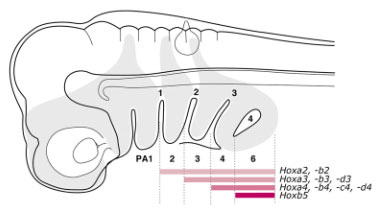| RIKEN Center for Developmental Biology
(CDB) 2-2-3 Minatojima minamimachi, Chuo-ku, Kobe 650-0047, Japan |
| So, why does the lamprey have no jaw? | ||
May 20, 2004 - The Hox code characterizes a family of master control genes that function to establish regional identities in the body segments of animals ranging from worm to human. First identified in studies of fruit fly mutants, Hox genes are now known to specify body regions along the anterior-posterior (head-to-tail) axis in both invertebrate and vertebrate species. Recent findings from the RIKEN Center for Developmental Biology (CDB) Laboratory for Evolutionary Morphology (Shigeru Kuratani, Team Leader), published in the May 20 issue of Nature, have shed new light on the question of a specific role for Hox genes in the evolution of the jaw. In jawed vertebrates, a group collectively known as "gnathostomes," the embryonic
region from which the jaws arise does not express Hox genes. This region, called the first pharyngeal
arch (PA1), is also found in the embryo of the lamprey, a jawless vertebrate (agnathan). A previous
study by another group reported the detection of the expression of a Hox gene in the lamprey PA1,
and suggested that the retreat of Hox gene expression from this region might have set the evolutionary
stage for the emergence of gnathostomes, on the premise that Hox genes have an inhibitory effect
on jaw development. Other experiments, in which either a Hox gene was artificially expressed in
the normally Hox-free gnathostome PA1 and found to suppress jaw development, or, conversely, in
which a Hox gene was inactivated in the normally Hox-expressing PA2, causing it to give rise to
jaw-like structures, tended to support the contention of an evolutionary role for Hox expression
in the innovation of the jaw.
The expression of Hox genes is collinear; that is, the order of their expression down the body
axis corresponds to their appearance on the chromosome. One of the most striking findings reported
in the previous work suggesting that the loss of Hox expression in PA1 might have facilitated
the branching off of the gnathostome lineage was that jawless chordates (such as lampreys and
lancelets) broke the supposedly universal law of Hox collinearity. Testing this surprising assertion,
Kuratani et al. isolated 11 Hox cDNAs in L. japonicum and checked their expression patterns in
developing embryos. They failed to detect Hox activity in PA1, or any evidence of a disruption
of collinearity, suggesting that this general principle is conserved in agnathans, as in all other
known taxa. They propose that the lack of Hox expression in PA1 in both jawed and jawless vertebrates
might instead simply reflect the fact that this structure gives rise to specialized structures
distinct from those that originate in more posterior pharyngeal arches in both groups. |
||
|
||
[ Contact ] Douglas Sipp : sipp@cdb.riken.jp TEL : +81-78-306-3043 RIKEN CDB, Office for Science Communications and International Affairs |
| Copyright (C) CENTER FOR DEVELOPMENTAL BIOLOGY All rights reserved. |
